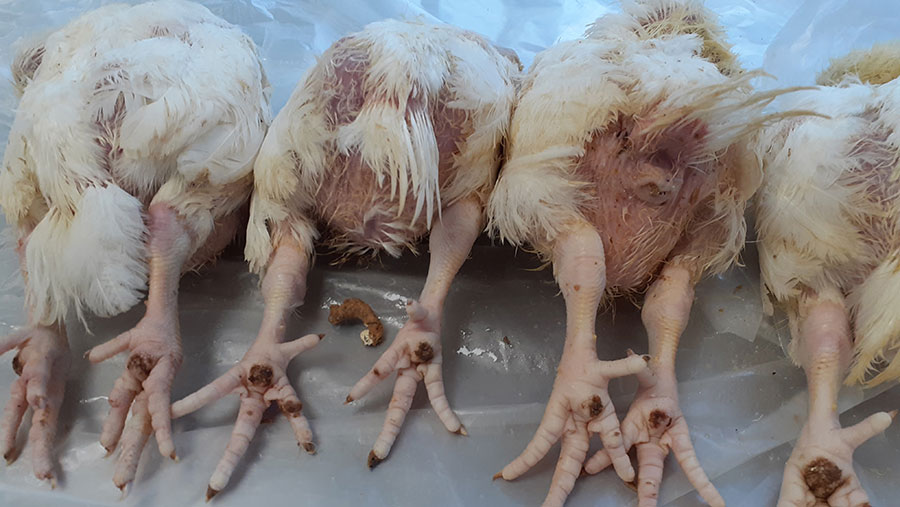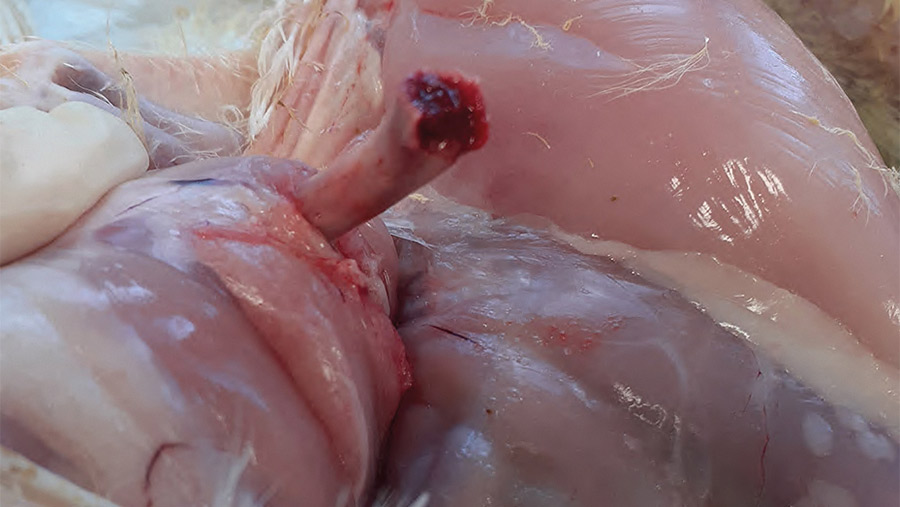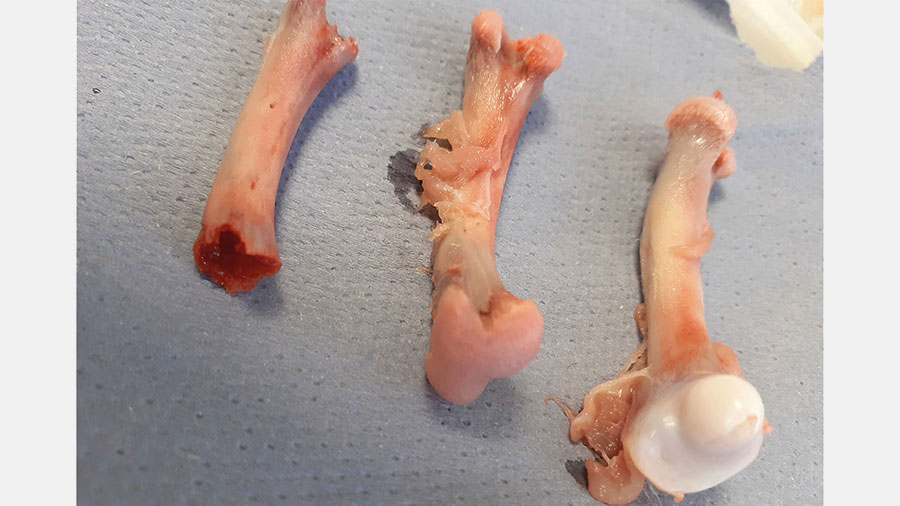How farmers can achieve better broiler leg health
 Broilers with pododermatitis on both feet © Poultry Health Services
Broilers with pododermatitis on both feet © Poultry Health Services Broilers are bred to be fast-growing, with average daily liveweight gains of about 68g and final kill weights typically exceeding 2.8kg, according to Aviagen Ross 308 performance objectives.
This makes them susceptible to leg health issues, which are estimated to reduce profits by 10-40%.
Vet Marie Menniti of Poultry Health Services, Edinburgh says it’s difficult to know the exact percentage because leg health impacts so many aspects of production.
See also: From start-up to sector leader – one broiler grower’s story
She advises prompt investigation in the following three areas when any trend toward an increase in leg problems is identified. Acceptable cull rates for leg problems should be less than 0.2%.
1. Welfare
Pain and gait abnormalities from leg problems will limit a bird’s mobility, which ultimately restricts access to water and feed, as well as freedom to perform natural behaviours.
“A stressed bird will divert energy resources away from production and immune function, so we see performance dropping and birds becoming more susceptible to disease, degrading their overall welfare,” she explains.
The UK’s welfare standards are high – but the development of leg health problems pose a challenge. When the bird’s welfare is compromised, humane culling is necessary.
And welfare is now a wider issue, says Ms Menniti: “Consumers are becoming more knowledgeable about the importance of welfare.
“They want to have food products from animals that have been kept in what they perceive to be excellent conditions.
Consumers in the Netherlands have made big changes in their country’s poultry production with a media campaign targeting retailers selling chicken from rapidly grown birds.
“Leg conditions are something they will call out specifically and there is now a preference for slower-growing birds, which generally have higher levels of welfare and health.
“For the producers, these slower-grown birds have become a value-added product,” says Ms Menniti.
“Right now in the UK, there isn’t a specific request for healthy legs from consumers – but it’s important that producers keep in mind what consumers want now and might want in the future.”
2. Production

Femoral head necrosis post mortem © Poultry Health Services
Compromised leg health can result in birds developing femoral head necrosis (FHN) – a bacterial infection causing septicaemic lesions and necrosis of the cartilage and femoral head.
FHN will generally present as birds underperforming, often accompanied by gait abnormalities.
“Birds may even try to use their wings to move around; in severe cases they will be completely immobile,” she explains.
“Stress fractures can leave birds more susceptible to developing FHN, and the disease is one of the most common causes of bird lameness.”
When birds are suffering from poor leg health, the recumbent behaviour can also mask other problems within the flock and delay diagnosis of other diseases and disorders.
The impact of poor leg health also extends to birds at slaughter.
“Broken bones, bruising, FHN and skin scratches from recumbency can all cause carcass downgrades and some could result in rejection at slaughter.”

Three femur-bones left to right: femoral head necrosis, detatched femoral head cartilage, healthy femoral © Poultry Health Services
3. Nutrition
Nutrition is key to healthy bone development. The ration needs to be formulated with the correct nutrients and ratios to build muscle and skeleton.
That means it needs to be digestible, metabolisable and palatable – but it is a real challenge to manage these changes and plan around the needs of the flock.
“It’s a case of meeting the nutritional requirements of that particular flock as they’re growing and supporting them with any challenges – that’s something a dedicated nutritionist can help with.”
Higher stocking density can lead to restricted access, decreased litter quality and increased disease risk, so making sure birds can access feed comfortably at all times will promote better health and welfare.
Inorganic v organic feed
Producers may have heard about the benefits of organic minerals and trace elements – but does it really matter?
Inorganic minerals – including macros and trace elements – are effective at providing birds with the nutrients they need. However, some mineral absorption can be blocked by the presence of other minerals.
“Feed mills typically use inorganic minerals, but include them at higher levels to counteract absorption losses,” says Ms Menniti.
Although this has worked in getting birds to their final slaughter weight, the industry is now looking at how organic minerals – minerals bound/encapsulated by an organic molecule such as a protein or enzyme – can refine feeding efficiency.
Organic minerals are more easily digested and absorbed, but they are more expensive. However, used in the right balance, they can help produce healthier, more efficient birds and bring economic gain.
Checklist
- Walk the shed: Observe and assess for environmental and behavioural abnormalities
- Look for signs of pain: If birds do not rise when you approach then there is likely an issue. Individuals need to be assessed to determine what is causing recumbency
- Track performance and lameness: Track production against breed performance objectives as well as feed and water consumption. Track the percentage and reason for lameness within a shed – post-mortem is useful in identification of causes of lameness
- Look at the feet: After assessing gait abnormalities check the feet of lame birds for conditions like pododermatitis
- Look for skin scratches: Look for and monitor the percentage of birds that have skin scratches as this is evidence that they are not as mobile as they should be
